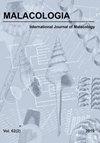三维形态学方法在机器学习辅助下对Dreissena属亲缘关系密切的双瓣化石物种进行分类中的性能
IF 1
4区 生物学
Q4 ZOOLOGY
引用次数: 4
摘要
摘要近年来,3D分析、描述形态结构复杂性的新指标和复杂的机器学习方法已经成为帮助物种确定的先进形态计量分析方法。然而,这些现代方法在确定隐蔽物种或化石分类群方面的适用性很少被研究。在这项研究中,使用里海四种现代Dreissena物种的化石和亚化石标本来测试基于3D的形态学方法在机器学习辅助物种识别中的性能。具体而言,壳体的3D扫描用于构建3D模型,用于计算“传统”壳体尺寸和“现代”壳体复杂性参数。最后,应用两种机器学习方法来测试壳体测量与壳体复杂性以及单个壳体参数与组合壳体参数的确定性能。结果表明:(i)基于外壳特征的物种识别没有优越的机器学习方法,(ii)外壳复杂性参数本身并不比外壳尺寸更适合物种识别,(iii)外壳参数的组合提高了测定性能并降低了它们的物种依赖性,以及(iv)单独的外壳特征不允许精确测定所研究的所有Dreissena物种。这些发现表明,最合适的机器学习方法、信息量最大的外壳字符和最佳的字符组合需要针对不同的数据集进行单独测试。然而,考虑到即使是专家也很难根据外壳特征来区分Dreissena物种,目前研究中的机器学习辅助分类表现相对较好。因此,基于机器学习的未来分析可能有助于专家有效处理大样本量,而非专家则可以合理确定地评估物种级别的信息。本文章由计算机程序翻译,如有差异,请以英文原文为准。
Performance of 3D Morphological Methods in the Machine Learning Assisted Classification of Closely Related Fossil Bivalve Species of the Genus Dreissena
ABSTRACT In recent years, 3D analyses, new indices to describe the complexity of morphological structures and sophisticated machine learning approaches have advanced morphometrical analyses to assist species determination. However, the applicability of these modern approaches to the determination of cryptic species or fossil taxa has rarely been investigated. In this study, fossil and subfossil specimens of the four modern Dreissena species in the Caspian Sea are used to test the performance of 3D-based morphological approaches for machine learning assisted species identification. Specifically, 3D scans of the shells were used to construct 3D models for calculating “traditional” shell dimensions and “modern” shell complexity parameters. Finally, two machine learning approaches were applied to test the determination performance of shell measurements vs. shell complexity and individual vs. combined shell parameters. The results show that (i) there is no superior machine learning approach to species determination based on shell characters, (ii) shell complexity parameters are not per se more suitable for species identification than shell dimensions, (iii) a combination of shell parameters increases determination performance and reduces their species dependence and (iv) shell characters alone do not allow precise determination of all Dreissena species studied. These findings suggest that the most appropriate machine learning approach, the most informative shell characters and the best combination of characters need to be tested individually for different data sets. However, considering that it is difficult even for experts to distinguish Dreissena species based on shell characters, the machine learning assisted classification in the current study has performed comparatively well. Future analyses based on machine learning may therefore help experts to process large sample sizes efficiently and non-specialists to assess species level information with reasonable certainty.
求助全文
通过发布文献求助,成功后即可免费获取论文全文。
去求助
来源期刊

Malacologia
生物-动物学
CiteScore
2.00
自引率
0.00%
发文量
15
审稿时长
3 months
期刊介绍:
Malacologia publishes papers on all groups of the Mollusca. Malacologia specializes in publishing long papers and monographic treatments. Complete data are especially appreciated. Papers must be of interest to an international readership. Papers in systematics, ecology, population ecology, genetics, molecular genetics, evolution and phylogenetic treatments are especially welcomed. Also welcomed are letters to the editor involving papers published or issues of import to science of the day.
 求助内容:
求助内容: 应助结果提醒方式:
应助结果提醒方式:


